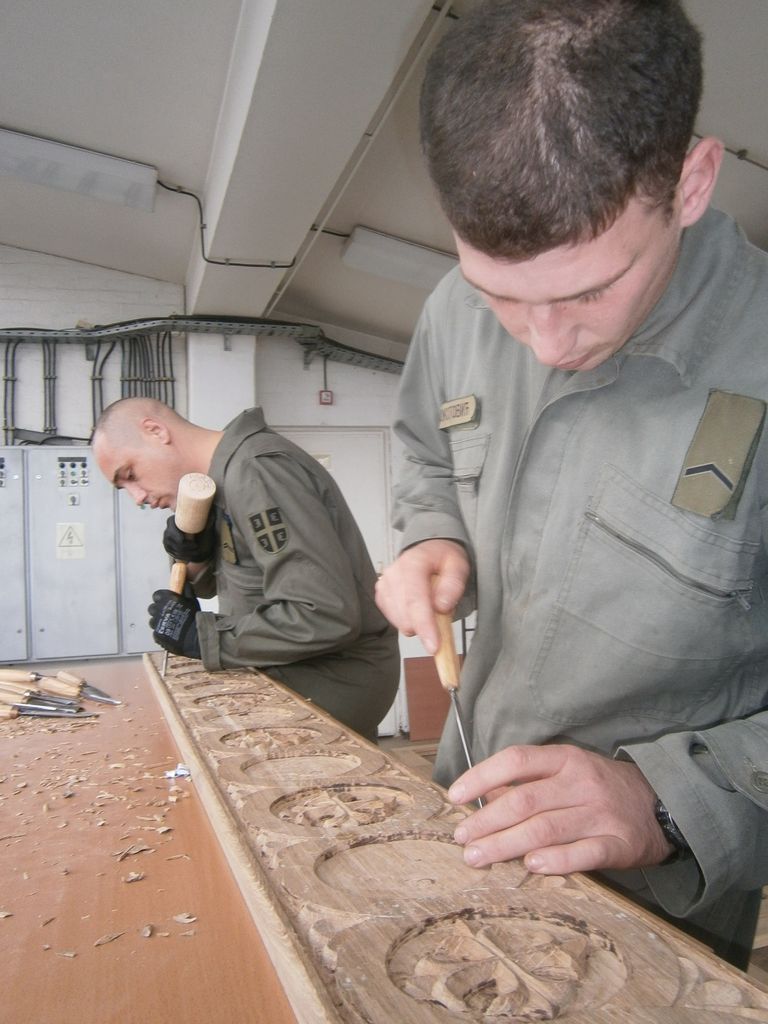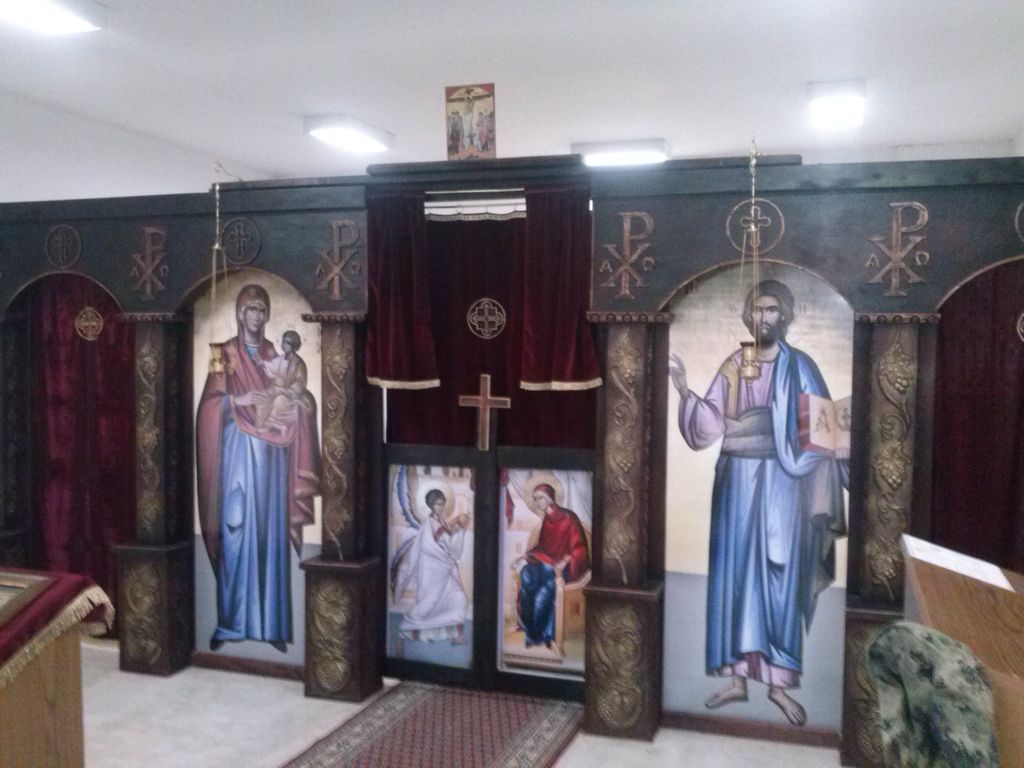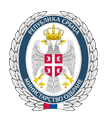25.08.2016.
Iconostasis creators - Corporal Vladan Djurovic and Lance Corporal Slobodan Kokotovic
 It is known that the Serbian military and the Serbian art have so much in common; so it can be argued without exaggeration that the Serbian art, during its development, builds also one war or military line. It is sufficient to recall many painters, writers, musicians and other artists in the ranks of the Serbian army, who used canvas, verses or notes to record many war episodes or details of military life. The names of Milutin Bojic, Stanislav Binicki, Kosta Milicevic and Djordje Andrejevic Kun, published literary works, art collections of the Military Museum and the famous tunes like "March on the Drina", testify to the long tradition and solid ties of art, wars and the military.
It is known that the Serbian military and the Serbian art have so much in common; so it can be argued without exaggeration that the Serbian art, during its development, builds also one war or military line. It is sufficient to recall many painters, writers, musicians and other artists in the ranks of the Serbian army, who used canvas, verses or notes to record many war episodes or details of military life. The names of Milutin Bojic, Stanislav Binicki, Kosta Milicevic and Djordje Andrejevic Kun, published literary works, art collections of the Military Museum and the famous tunes like "March on the Drina", testify to the long tradition and solid ties of art, wars and the military.The Serbian Army also has a rich tradition of art in its own ranks, which was manifested not only in the organization of exhibitions, art colonies, literary evenings, concerts and other cultural events, but also in the fact that in the bosom of the Army there emerged and are growing individuals who manage to share their personal enthusiasm and part of themselves and their artistic creation with their colleagues, friends and art connoisseurs. Their works of art are diverse, belonging to different artistic directions and are emerging from special inspiration sources, but they are united by belonging to the Serbian Armed Forces and the commitment to contribute by their actions to the overall Serbian art. Recently, a long line of artists of the Army were joined also by professional soldiers of the Second Army Brigade, Corporal Vladan Djurovic and Lance Corporal Slobodan Kokotovic, who have distinguished themselves by creating original and inspired design of iconostases for the purposes of liturgical spaces in the Serbian Armed Forces.
WOODCUT ART
Task of the Group for Religious Affairs of the Second Army Brigade, in addition to the divine service scope of work, includes spiritual counselling with soldiers and influence on raising the operational capabilities of each individual in the military. Visiting the units in the field and in all barracks within the jurisdiction of the Second Army Brigade it was found that in the brigade units there are plenty of soldiers who, in addition to their professional engagement in the army, have affinity for iconographic and woodcutting art or carpentry trade. It was not long after this finding that the idea came up that soldiers with artistic and craft inclinations might be also engaged in the promotion of the religious service, which was still in its infancy at that time and whose needs were primarily related to the formation and organisation of liturgical spaces.
Members of the Group for Religious Affairs, with their pastoral-catechetical work, gained insight into the work of the engraver Corporal Vladan Djurovic and carpentry skills of Lance Corporal Slobodan Kokotovic and proposed them to create an iconostasis for the liturgical space in the Stefan Nemanja barracks in Raska. The iconostasis is, by the way, a barrier that separates the sanctuary from the rest of the church space and includes icons; it exists only in Orthodox churches. A place for icons is necessary in any church, and so it is in the service areas of the Serbian Armed Forces.
Professional soldiers Vladan Djurovic and Slobodan Kokotovic wholeheartedly embraced the proposal by a military priest to create iconostasis of carved wood and they soon started making it. The first iconostasis of Corporal Djurovic and Lance Corporal Kokotovic left breathless all visitors of the liturgical space in the Stefan Nemanja barracks, and its appearance impressed Bishop of Raska and Prizren Teodosije himself, who also consecrated the iconostasis and the whole liturgical space a few months after its preparation. Bishop Teodosije was especially delighted as the iconostasis was done by members of the Serbian Armed Forces.
In the months that followed, Djurovic and Kokotovic created iconostasis for the newly formed liturgical space in the Petar Lekovic barracks in Pozega, which was consecrated by Justin, bishop of Zica. The final and the last work was on the iconostasis in the liturgical space in Rifat Burdzevic – Trso barracks in Novi Pazar, which is among the best liturgical spaces in the Serbian Armed Forces, according to the general opinion. Good news travels fast, so the creative woodcutter and an accomplished carpenter began to engage in making the iconostases in the liturgical spaces of the units outside the composition of the Second Brigade. These days they are making an iconostasis for the purpose of the liturgical space at the Army Command in Nis.
INDIVIDUAL STYLE
Corporal Vladan Djurovic is serving as gunner operator on BVP M80A in the 27th mechanized battalion of the Second Army Brigade. He lives in a village of Jovac near Kraljevo, and it has been for years that he spent most of his free time in making various items in wood. It should be noted that woodcutting is not only simple woodworking, but it is real art that requires a man to breathe life into a piece of wood, and that he has good command of serious artistic skills. Artistic processing of wood or carving art has a long tradition in Serbia, and the tools and skills were passed on from generation to generation.
 "The artist is the one who is different – Corporal Djurovic says – not the one who is indistinctive. There are no more schools of woodcutting that existed before, so that every carver should be distinguished by his individual style". For Vladan Djurovic, creating iconostases was a special challenge, since for carving on the iconostasis he had to acquire knowledge of biblical theology, the history of religion and the church art. The acquired knowledge has largely contributed to our easy perception of a strong presence of biblical ornamentation in the iconostasis, as well as multiple layers of artistic expression, and in the end, extremely high levels of skill of the artists in carving.
"The artist is the one who is different – Corporal Djurovic says – not the one who is indistinctive. There are no more schools of woodcutting that existed before, so that every carver should be distinguished by his individual style". For Vladan Djurovic, creating iconostases was a special challenge, since for carving on the iconostasis he had to acquire knowledge of biblical theology, the history of religion and the church art. The acquired knowledge has largely contributed to our easy perception of a strong presence of biblical ornamentation in the iconostasis, as well as multiple layers of artistic expression, and in the end, extremely high levels of skill of the artists in carving.Woodcut is a sculpture made of wood, and in order for an artist to be able to carve well it is necessary to pre-process the wood. It was exactly the wood processing which was the task for Lance Corporal Slobodan Kokotovic, who has been serving as a sniper in the command battalion of the Second Brigade. The task was not difficult for Slobodan, since he has been working in the family carpentry workshop in the village of Raonic on the Gledicka mountains for years.
"Iconostases are made of top quality wood species, mostly of oak – Lance Corporal Kokotovic says – and on the iconostases that we have created, the aesthetic advantages of wood compared to other materials, wood processing skills and the art of carving, are most visible".
Working on iconostases, Vladan Djurovic and Slobodan Kokotovic became friends. They often work in the room of the military club in Ribnica barracks in Kraljevo which was adapted for performing such work. Creating of a five-meter-long iconostasis lasts five to six months, so that the professional soldiers often worked all day or on weekends. It was not hard for them, as they say, and they are proud of their work and the fact that many liturgical spaces look better with their original handmade iconostases.

